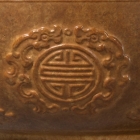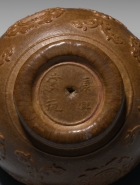J.J. Lally & Co., Oriental Art / New York City, New York
MenuPast Exhibition
ELEGANTLY MADE: Art for the Chinese Literati
March 13-27, 2020
26.
AN IMPERIAL MOULDED GOURD BOWL
Kangxi shangwan mark and of the period (1662-1722)
the natural gourd grown into a mould with four shou character medallions flanked by dragon-scrolls and separated by pairs of phoenix-head scroll motifs, all in relief on the exterior of the rounded sides, the skin of warm honey brown color, the interior lacquered black, the rounded foot of irregular outline encircling the imperial mark moulded on the recessed base: Kangxi shangwan (For the amusement of Kangxi emperor).
Diameter 4 1⁄2 inches (11.4 cm)
Provenance
Sotheby’s Hong Kong, Fine Chinese Works of Art, Furniture, Jade Carvings, Jadeite Jewellery and China Trade Paintings, 30-31 October 1991, lot 341
Collection of Mary and George Bloch
Sotheby’s Hong Kong, Scholarly Works of Art from the Mary and George Bloch Collection, 23 October 2005, lot 128
Shuisongshi Shanfang Collection
The simple folk craft of moulded gourds was transformed into an imperial art form by the Kangxi emperor who instituted the cultivation and moulding of gourds within the precincts of the Palace late in the 17th century.
Compare the moulded gourd bowl with everted rim similarly decorated with four shou character medallions flanked by dragon-scrolls, with Kangxi shangwan mark on the base, illustrated by Wang, Shuo hulu (The Charms of the Gourd), Hong Kong, 1993, p. 73, fig. 5.
Compare also the moulded gourd bowl, unmarked but attributed to the Qianlong period, from the collection of Sir John Addis, now in the Victoria and Albert Museum, illustrated by Clunas, Chinese Carving, Singapore, 1996, p. 67, fig. 82.
清康熙 御製壽字紋匏碗 徑 11.4 厘米
「康熙賞玩」單圈款
來源 香港蘇富比 1991 年 10 月 30-31 日,拍品第 341 號
瑪麗與莊智博舊藏
香港蘇富比 2005 年 10 月 23 日,拍品第 128 號
水松石山房藏

